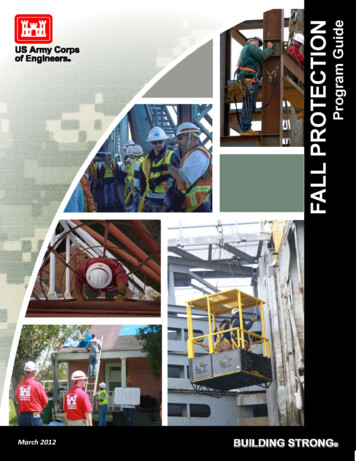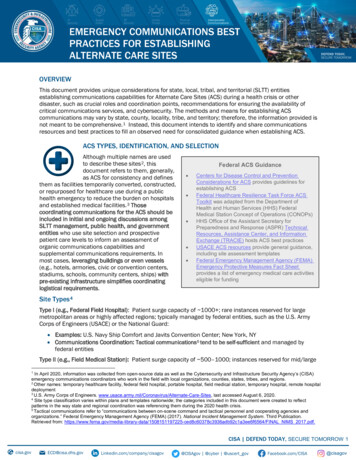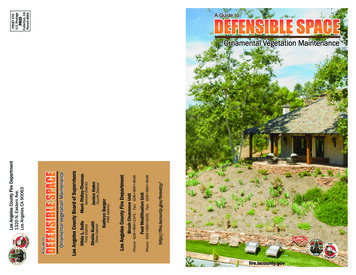
Transcription
USACE FP Guide1 April 2012USACE Fall Protection GuideTable of ContentsChapter 1Introduction1-1Chapter 2Fall Protection Program2-1Chapter 3Duties and Responsibilities3-1Chapter 4Workplace Survey and Assessment of Fall Hazards4-1Chapter 5Training5-1Chapter 6Fall Hazard Prevention and Controls6-1Chapter 7Fall Protection Systems, Criteria and Design Requirements7-1Chapter 8Fall Protection Guidelines for Specific Work Applications8-1Chapter 9Guidance For Fall Rescue Procedures9-1Chapter 10Inspection, Maintenance, Storage and Care Procedures for FallProtection Equipment10-1Chapter 11Tie-Off Considerations and Selection of Safe Anchorages11-1Chapter 12Responsibility for Design, Inspection, Certification, and ReCertification of Anchorages12-1Chapter 13Fall Prevention Considerations During Planning and Design Phase13-1Chapter 14Other Protective Measures14-1Chapter 15New American National Standards Institute (ANSI) Z359 FallProtection Standards15-1Appendix AFall Protection ComparisonsA-1Appendix BWritten Fall Protection Program Sample/TemplateB-1Appendix CSample Fall Hazard Survey ReportC-1Appendix DFall Protection Training RosterD-1i
Appendix ESample Fall Protection and Prevention PlanE-1Appendix FDefinitionsF-1Appendix GFiguresG-1Appendix HChecklistsH-1ii
USACE FP Guide1 April 2012Chapter 1Introduction1. Purpose. This Guide establishes criteria and requirements for developing and managing FallProtection (FP) programs to protect all personnel at USACE-Owned/Operated Facilities.2. Background. Falls are a leading cause of work-related injuries and fatalities, with thousandsof workers suffering injuries due to falls with lost time from work, and half of all fall fatalitiesoccurred in the construction industry. The intent of this guide is to establish criteria,requirements and best practices for fall protection programs in order to heighten awareness andprotect all personnel exposed to fall hazards in the workplace. Falls are preventable and carefulplanning and preparation lays the necessary groundwork for an accident-free workplace.3. Application. This guide applies to all USACE-Owned/Operated Facilities where there is aneed for a Fall Protection program to ensure the safety of all personnel. It provides informationon standards, regulations, and criteria and requirements for the protection of personnel andworkers working at heights and exposed to fall hazards.4. USACE Fall Protection Policy. Per the USACE Safety and Health Requirements Manual,EM 385-1-1, every facility having personnel working at heights, exposed to fall hazards andusing fall protection equipment is responsible for establishing, implementing and managing aFall Protection Program, which includes identification and elimination or control of fall hazards.These facilities are responsible for: assigning responsibilities; surveying and assessing fallhazards; providing prevention and control measures; training of personnel; inspecting fallprotection equipment; auditing and evaluating effectiveness of the program; and ensuring properinstallation and use of fall protection systems and providing rescue equipment withaccompanying rescue procedures. Fall protection must be provided to personnel exposed to fallhazards on any elevated walking/working surface with unprotected side, edge, or floor openings,from which there is a possibility of falling four feet or more to lower level or where there is apossibility of a fall from any height onto dangerous equipment, into a hazardous environment, oronto an impalement hazard.5. Facility Fall Protection Policy. Each facility may prescribe supplemental requirements forspecial conditions above and beyond the USACE policy stated in paragraph 4 above.Developing a facility-specific policy will provide guidance and requirements and delineateresponsibilities at the facility. A facility-specific policy should emphasize management’scommitment to provide a safe work environment for personnel working at heights and the factthat safety of personnel during performance of their work is of the utmost importance.6. Basic Requirements for Fall Protection. The threshold limit for providing fall protection ismandated by EM 385-1-1 and OSHA.a. The standard fall protection threshold for federal employees in our facilities is 4 feet asper EM 385-1-1 and OSHA’s General Industry Standards, 29 CFR 1910, Subpart D.1-1
USACE FP Guide1 April 2012b. At construction sites, workers shall adhere to the threshold height no greater than 6 feet,as per EM 385-1-1 and OSHA’s Construction Industry Standards, 29 CFR 1926.500, Subpart M.When USACE employees visit construction sites to inspect contractor work, they shall complywith the 6 ft threshold.c. If there is a potential to fall onto dangerous equipment, into a hazardous environment, oronto an impalement hazard from any height, the employee must be protected.For information only, the following is a table indicating the threshold for various industries:IndustryContractor or ConstructionGeneral IndustryFeet64Regulations SourceEM 385-1-129 CFR 1926.500EM 385—1-129 CFR 1910.23Shipyard529 CFR 1915.159Marine Terminals429 CFR 1917.112Long-Shoring829 CFR 19187. Compliance. 29 CFR 1960, Section 19 of the Occupational Safety and Health Act (OSHA)of 1970 and Executive Order 12196 prescribes requirements for federal occupational safety andhealth programs and contains provisions to assure safe and healthful working conditions forfederal employees. Under Section 19 of the OSHA Act and 29 CFR 1960.16 (for FederalAgencies), Occupational Safety and Health programs shall be consistent and in compliance withthe standards promulgated under Section 6 of the Act. Section 6 directs, by rule, the Secretary ofLabor to promulgate the OSHA Standard 29 CFR 1910.a. USACE personnel shall comply with the EM 385-1-1 and 29 CFR 1910 requirement of 4feet as stated under Subpart D, Walking-Working Surfaces, unless there are other alternatepromulgated standards that are more specific to an Activity, Command, or industry, such as the 6foot requirement for USACE contractors performing construction and demolition work.b. Therefore, at USACE-owned/operated facilities fall protection must be provided to eachemployee on any elevated walking/working surface ABOVE 4 FEET including working fromfixed ladders and where there is a possibility of a fall to a lower level, onto dangerousequipment, into a hazardous environment, or onto an impalement hazard.Exceptions: (1) When climbing ladders, or (2) when erecting or dismantling supportedscaffolds, when it is determined by a competent person after conducting an evaluation, thatproviding fall protection is not feasible or creates a greater hazard (i.e., when it isnecessary to erect scaffolding before the structure and requiring the scaffold structure tobe erected or put in place).1-2
USACE FP Guide1 April 20128. Comparison between OSHA and EM 385-1-1 Fall Protection Requirements. Appendix Aprovides a comparison between various OSHA and USACE EM 385-1-1 fall protectionstandards. All the fall protection standards, regulations and requirements are similar in theapplication and use of fall protection equipment. A primary difference is the threshold limit atwhich fall protection is required (4, 5, or 6 feet heights). These heights impact the level at whichtemporary guardrails and work platforms are installed or used. Fall arrest equipment cannot beused at these elevations as the minimum clearance required for using fall arrest systems safely isapproximately 11 feet [depending on the length of the lanyard, type of lanyard (e.g., selfretracting lanyard), and the height of anchorage point]. Other fall arrest systems require moreclearance. Fall restraint, travel restraint and warning line systems may be used at any elevationand are not impacted by the prescribed threshold limits of 4, 5 and 6 feet, because if using thesesystems, the user will not be exposed to a fall hazard.9. Regulations and Standards.a. EM 385-1-1. It shall be included and enforced on all DoD contracts involvingconstruction, dismantling, or demolition or removal work. In addition, EM 385-1-1 shall berequired for service, supply, and research and development contracting actions unless technicalrepresentatives (in conjunction with safety and health professionals) advise that specialprecautions are not appropriate. Contractors performing such work shall comply with allpertinent provisions of the latest version of the manual (FAR 52.236-13).b. 29 CFR, PART 1926.500, Subpart M, Fall Protection Requirements in the ConstructionIndustry.c. 29 CFR, PART 1910, Occupational Safety and Health Standards for General Industry.d. 29 CFR PART 1915, Occupational Safety and Health Standards for ShipyardEmployment.e. 29 CFR 1917, Marine Terminals.f. 29 CFR PART 1918, Safety and Health Regulations for Long shoring.g. 29 CFR PART 1960, Basic Program Elements for Federal Employee Occupational Safetyand Health Programs.h. DoD Directive 6055.1, Occupational Safety and Health Program.i. American National Standards Institute (ANSI), Z359 Fall Protection Code, (24November 2007).j. Unified Facilities Guide Specification (UFGS) 01 35 26 Governmental SafetyRequirements.k. NLI A14.3 (R2008) Safety Requirements for Fixed Ladders.l. Unified Facilities Criteria (UFC) (2007) Roofing Maintenance and Repair.1-3
USACE FP Guide1 April 2012Chapter 2Fall Protection Program1. General. Each USACE-Owned/Operated facility that has personnel exposed to fall hazardsis required to establish and implement a Fall Protection program per EM 385-1-1. The managedFall Protection Program shall be in writing, reviewed and approved by the local Safety office. As an alternative to this requirement, a USACE-Owned Facility, in lieu of a separatewritten program with the safety office review and approval, may state in writing that itis using this guide as their Fall Protection program. Site specific requirements wouldbe included, to include Appendix B.2. Components of the Fall Protection Program.a. Facility policy.b. Duties and responsibilities.c. Workplace surveys and assessment of fall hazards.d. Training Requirements.e. Fall hazard prevention and control, including the preparation of Fall Protection andPrevention Plans.f. Inspection, storage, care, and maintenance of equipment.g. Rescue procedures.h. Mishap reporting.i. Audits and evaluation.3. Fall Protection Program Format. A written Fall Protection Program sample/template can befound in Appendix B.2-1
USACE FP Guide1 April 2012Chapter 3Duties and Responsibilities1. General. USACE facilities shall delineate duties and assign responsibilities to qualified andtrained personnel involved in the development and management of the Fall Protection Program.Each facility shall ensure that assigned personnel have the necessary skills, knowledge, trainingand expertise to mange, administer, and implement the Fall Protection Program.2. Fall Protection Program Manager/Administrator. The duties and responsibilities of the FallProtection Program manager/administrator include, but are not limited to, the following: Developing and managing the Fall Protection Program at the activity; Ensuring all personnel exposed to fall hazards and using fall protection equipment areadequately trained before using the equipment; Ensuring other personnel involved in the Fall Protection Program are adequately trained; Developing overall fall protection training programs; Developing and approving fall protection equipment purchases; and Evaluating the Fall Protection Program effectiveness.3. Qualified Person (Qualified Person) for Fall Protection (reference Appendix Q of EM 385-11). The Qualified Person for Fall Protection shall also meet the qualifications of a CompetentPerson for Fall Protection. The duties and responsibilities of the Qualified Person for FallProtection include, but not limited to, the following: Supporting the Fall Protection Program; Preparing, reviewing, approving and modifying:o Fall Protection and prevention plans;o Rescue plans and procedures; Designing, selecting, certifying, evaluating, and analyzing fall protection systems andequipment; Designing or supervising the design, selection, installation and inspection of certifiedanchorages and horizontal lifelines; Reviewing, preparing, and approving project fall protection specifications;3-1
USACE FP Guide1 April 2012 Preparing contract documents for fall protection systems; and Having knowledge of all fall protection standards and regulations.4. Competent Person For Fall Protection (reference Appendix Q of EM 385-1-1). The dutiesand responsibilities of the Competent Person for Fall Protection include, but are not limited to,the following: Immediate supervision (in conjunction with the Fall Protection Program Manager),implementation and monitoring of the Fall Protection Program; Preparation and implementation of:o Fall Protection and prevention plans;o Rescue plans and procedures; Identification of hazardous and dangerous conditions in the workplace and take promptcorrective measures to correct them; Conducting fall hazard surveys and prepare survey reports; Inspection and installation of approved fall protection systems; Ensuring end users working at heights and using fall protection equipment are adequatelytrained; Supervising the selection, installation and inspection on non-certified anchorages; Understanding and knowledge of fall protection systems and equipment; Conducting inspections and accident investigations; Having full responsibility and authority to implement the Fall Protection and PreventionPlan and Rescue Plan procedures; Knowledge of fall protection regulations and standards; Monitoring employee compliance with the Fall Protection and Prevention Plan andRescue Plan requirements.3-2
USACE FP Guide1 April 2012Chapter 4Workplace Survey and Assessment of Fall Hazards1. Fall Hazard Survey. A fall hazard survey will identify potential fall hazards in theworkplace. The gathered information will provide documentation to assist in the development ofviable solutions to protect personnel exposed to fall hazards. Understanding work proceduresand how a person conducts the required task is very important in the selection and developmentof the most appropriate fall protection method. A fall hazard survey will help identify optionsfor fall hazard elimination and/or selecting other control measures. The fall hazard survey shallbe conducted annually and the survey information, required for identifying fall hazards atexisting buildings or facilities should include, at a minimum:a. Interview of end user(s) and their supervisors;b. Work-paths and movement of the end users;c. Range of mobility in each fall-hazard zone;d. Location and distances to obstructions;e. Potential anchorage location, if a fall hazard cannot be eliminated or prevented;f. Available clearance and total fall distance;g. Number of personnel exposed to fall hazards;h. Frequency and duration of exposure;i. Lock-Out/Tag-Out hazards;j. Potential severity of falls;k. Access or egress to fall-hazard area;l. Condition of floors and other surfaces, to include load-bearing capacity;m. Reviews of any fall mishap reports at the facility;n. Identification of the presence of: Hot objects, sparks, flames, and heat-producing objects; Electrical and chemical hazards; Sharp objects;4-1
USACE FP Guide1 April 2012 Abrasive surfaces; Moving equipment and materials; Weather factors; and Any other maintenance, work environment issues or conditions2. Structural Integrity of walking/working surfaces. Facilities shall determine if the walking orworking surfaces on which employees are to walk or work have the strength and structural integrityto safely support the workers. Employees shall not be permitted to work on those surfaces until it hasbeen determined that the surfaces have the requisite strength and structural integrity to support theworkers and equipment related to their tasks. Once it has been determined that the surface is safe foremployees to work on, then it should be determined if a fall hazard exists at the work location.3. Visiting Employees/Contractors. If visitors or contractors are visiting or performing work atthe facility where the worksite is located and fall hazards or potential fall hazards areencountered, they will work under the project Fall Protection Plan or develop their own if the fallhazards are not addressed under the project Fall Protection Plan.4. Fall Hazard Assessment. After conducting the fall hazard survey at a workplace, a hazardanalysis can be performed to assess the risk, hazard severity, and fall mishap probability. Thiswill help in prioritizing the hazard ranking and selection of the most viable fall protectionsolutions. The primary consideration is to eliminate/remove potential fall hazards from the workplace.5. Fall Hazard Survey Report. The following are guidelines for preparing a report: A survey shall be conducted for each fall hazard to which a person may be exposed; The report shall identify one or more methods to eliminate or control fall hazards; A person who is familiar with building operations and work procedures shouldaccompany the individual conducting the survey; The survey should include pertinent information as to the type of fall hazard showingbasic configuration (drawings/photos); The report shall identify environmental factors that may affect the building/facility; The report shall establish risk factors to assist in hazard ranking; The report shall be revised whenever there is a change in work procedure/task equipmentor requirements that will render the previous report obsolete;4-2
USACE FP Guide1 April 2012 Interview personnel that will be working at heights and exposed to fall hazards. Note: The survey should be conducted by the Competent Person for FallProtection. The Competent Person can train and delegate another person to assistwith the survey.A Sample Fall Hazard Survey Report can be found in Appendix C.4-3
USACE FP Guide1 April 2012Chapter 5Training1. Training Requirements. All USACE personnel working at heights, exposed to fall hazardsand using fall protection equipment or other personnel involved in the Fall Protection Programshall be trained to recognize the hazards of falling in the workplace and how to minimize suchhazards.a. Before using fall protection equipment, the employee must be trained in the safe use ofequipment. It is recommended that all employees exposed to fall hazards receive a minimum of4-8 hours of fall protection training including hands-on training, or as appropriate.b. Annual refresher training shall be provided as necessary for employees to maintain anunderstanding of these subjects.c. Written certification of training is required and shall be maintained at the job site for theduration of the work. For those visitors working under the project Fall Protection Program, theyshall provide a certificate of training. The certificate shall identify the name of the employeetrained, date of training, and the signature of the trainer. Additionally, a determination shall bemade as to whether the training has resulted in personnel acquiring the required skills andknowledge.d. A daily “Tool Box” meeting shall be conducted before work is begun to discuss fallhazards for that day and to remind workers to comply with the established Fall Protectionprocedures.e. For USACE personnel who may be in a situation that requires climbing involving the useof fall arrest systems, the end user training shall also include practical climbing in a controlledsituation in the presence of a Competent Person for Fall Protection. Additionally, end users shallbe trained in rescue and self-rescue equipment and procedures. A Competent Person who has theknowledge, expertise, and education to deliver the training shall train end users. The CompetentPerson should also be qualified as a Fall Protection trainer for end users.f. Hands-on training is also required for investigation and inspection work.g. Architects, engineers, and designers involved in planning and designing buildings,facilities, and structures shall be knowledgeable in fall protection and prevention controlmeasures and incorporate fall protection measures into their design work to help contractorsduring the construction phase and to provide protection to USACE personnel performing theirwork during normal operations and maintenances. Training requirements for other USACEpersonnel involved in the Fall Protection Program and not listed in paragraph 4.2 shall bedetermined by the Fall Protection Program Manager.5-1
USACE FP Guide1 April 20122. Fall Protection Training Matrix. All training shall be based on the requirements ofANSI/ASME Z359 (2007 ). The following training matrix requirements and methodsidentify the degree of training for various USACE personnel:Fall Protection Training Requirements and MethodsTrainee GroupEnd User/AuthorizedPersonsSafety ProfessionalsConstructionManagers/QualityAssurance PersonnelDesired Training Objectives- Selection and safe use of equipment- Application limits- Proper anchoring and tie-off techniques- Estimation of fall distances- Determination of deceleration distance- Total fall distance- Methods of inspection- Storage, care, and maintenance ofequipment- Applicable regulations Limitations ofequipment- Specific lifelines- Rescue and self rescue techniques- Recognize fall-hazard deficiencies- Recognize fall risks at worksite- Recognize fall hazard deficiencies- Recognize fall risks at worksite- Basic fall protection systems andequipment- Methods of use- Proper anchoring and tie-off techniques- Methods of inspection and record keeping- Storage of the equipment- Applicable regulations- Rescue equipmentand procedures5-2Training Mechanism, Typeand LengthFormal/hands-on training usinglocal equipment or on-sitetraining as applicable to theactivity(2-8 hours or as appropriate,deemed by a Competent Personfor Fall Protection)Refresher training – 1 hourannually.Interactive CD-ROM or FormalClassroom
USACE FP Guide1 April 2012Trainee GroupCompetent Person forFall Protection(As Designated by theFacility or Designatedin Writing as theCompetent Person)Qualified Person forFall ProtectionArchitects andEngineers (Designers)involved in planningand design of buildings,facilities and structuresFall Protection ProgramManagers/AdministratorsSupervisors of EndUsersDesired Training Objectives- In addition to the authorized persontraining, training shall also include:-Various fall protection systems- Donning of the equipment- Proper inspection and record keeping- Recognize and identify fall hazards atwork-site- Equipment installation techniques- Proper anchoring and tie off techniques- Risk assessment and hazard ranking- Preparation, update, review and approval ofFall Protection and Prevention plans, andRescue and Evacuation plans- Applicable fall protection regulations - Planand specification review and approval- Design, select, analyze, and certify fallprotection systems and equipment- Preparation, update, review, and approvalof fall protection and prevention plans, andrescue and evacuation plans- Fall protection regulations and standards Plan and specification review and approval- Understand various fall protection andprevention planning and designconsiderations during construction andmaintenance phases- Recognize fall hazard deficiencies- Recognize fall risks assessment and controlmeasures at worksites- Basic systems identification and proper use- Recognize and identify fall hazards atworkplaces- Risk assessment and hazard ranking- Selection, safe use, and limitation of fallprotection systems and equipment- Storage, care, and maintenance of theequipment- Applicable fall protection regulations- Fall protection awareness training- Familiarization with SOPs- Local program requirements- Proper inspection and record keeping- Proper anchoring and tie-off techniques5-3Training Mechanism, Typeand LengthFormal Training(Minimum 32 hours, includinga minimum of 16 hoursclassroom and 8 hours ofhands-on)Formal Classroom(40 hours or as appropriate)Formal Classroom(Awareness Training)Qualified or Competent Personformal training.Local Training plan/briefing,and/or instruction, SOPor Web Based Training(Awareness Training)
USACE FP Guide1 April 20123. Refresher/Update Training. Personnel exposed to fall hazards shall receive refresher/updatetraining on the safe use of fall protection equipment and rescue in the following:a. End users, Program Manager/administrator, and the authorized rescuer (in-house personwho conducts rescue): Fall Protection - minimum of one hour refresher training annually to staycurrent with fall protection and rescue requirements.b. Fall Protection Competent and Qualified Person for Fall Protection: Refresher /updatetraining every two years.4. Fall Protection Training Roster.a. All employees newly assigned to a job must review and understand the Fall Protectionand Prevention Plan if working under the plan. Whenever the fall hazards, fall protectionequipment, or methods change during the course of the job, the Fall Protection and PreventionPlan must be reviewed again by all employees working at the job site. Employees shall betrained in job hazard recognition and shall be trained in the proper use of fall protectionequipment. Procedures may be developed at the local level to ensure compliance.b. All contractor and subcontractor workers exposed to fall hazards shall be trainedaccordingly.c. If additional requirements arise or change at the job site as work progresses, the FallProtection and Prevention Plan and Rescue Plan shall be reviewed and updated by a Qualified orCompetent Person and signed by all workers exposed to fall hazards.d. For those employees or contractors visiting to perform work at heights and exposed tofall hazards at the USACE activity being visited and before starting work at that site, they shallbe trained on the proper use of fall frotection and rescue equipment.5. Training roster. A Fall Protection training roster can be found in Appendix D.5-4
USACE FP Guide1 April 2012Chapter 6Fall Hazard Prevention and Controls1. Hierarchy of controls. USACE-Owned Facilities shall select fall protection control measurescompatible with the type of work being performed. If fall hazards cannot be eliminated, fallprotection can be provided through the use of fall protection systems and equipment and inaccordance with Chapter 6 of this guide. The preferred order of control measures for fall hazardsare:a. Elimination - Removing the hazard from a workplace. This is the most effective controlmeasure e.g., lower various devices or instruments, such as meters or valves to the height level of theindividual, instead of servicing such devices or instruments at heights;b. Prevention (traditional) - Isolating or separating the hazard from the general work areas e.g.,same level barriers such as guardrails, walls, covers or parapets;c. Work Platforms (movable or stationary) – Use scaffolds, scissor lifts or aerial lift equipmentto facilitate access to work location and to protect personnel from falling when performing work athigh locations;d. Personal Protective Systems and Equipment - These shall be used after other controlmeasures (such as eliminating or isolating fall hazards) are determined not to be practical, or when asecondary system is needed e.g., when it is necessary to increase protection by employing a backupsystem;e. Administrative Controls - This includes introducing new work practices that reduce therisk of a person falling e.g., erecting warning lines or restricting access a work area. NOTE: Control measures are not mutually exclusive. There may be situations whenmore than one control measure should be used to reduce the risk of a fall.2. Fall Protection and Prevention Plans. The Fall Protection & Prevention Plan, as required byUSACE EM 385-1-1, Paragraph 21.C.01 is a document prepared by each USACE-OwnedFacility for the purpose of planning, designing, installing, monitoring, and rescuing workersexposed to fall hazards and to prevent fall accidents from occurring in the workplace. It is aliving document that will require modification due to changes during different phases of work,procedures, or methods of construction or maintenance work.a. A Qualified Person for Fall Protection or Competent Person for Fall Protection shall beresponsible for preparing the Fall Protection & Prevention Plan, as well as making any requiredchanges, designs, updates, or approvals relating to various methods and requirements pertainingto Fall Protection systems.6-1
USACE FP Guide1 April 2012b. It is of utmost importance that a Fall Protection & Prevention Plan be prepared andapproved prior to start of work. The plans shall be kept at the work site at all times, with anychanges noted. Note: The American National Standards Institute, ANSI Z359 Standard, titled“Minimum Requirements for a Comprehensive Managed Fall ProtectionProgram” identifies the Fall Protection and Prevention Plan as “Written FallProtection Procedures”. According to EM 385-1-1, Paragraph 21.C.01,preparation of the Fall Protection and Prevention Plan is a requirement as part ofthe fall protection program3. Fall Protection & Prevention Plan requirements. The Fall Protection & Prevention Plan isdifferent from a Fall Protection Program required per 29 CFR 1926.502(k). A Fall ProtectionPlan as required by OSHA is available only to employees who can demonstrate that it isinfeasible or it creates greater hazard to use conventional Fall Protection systems: (i.e., guardrail,safety nets, or personal fall arrest system). The Fall Protection & Prevention Plan is a documentthat includes written procedures for performing a specific work, task, or project, indicating theproper way of using safe fall protection systems and equipment and any other relevantinformation. However, it is a requirement to develop Fall Protection & Preve
USACE FP Guide 1 April 2012 1-2 b. At construction sites, workers shall adhere to the threshold height no greater than 6 feet, as per EM 385-1-1 and OSHA’s Con










